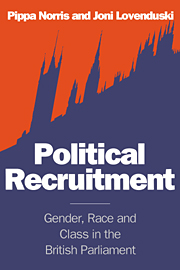Book contents
- Frontmatter
- Contents
- List of figures
- List of tables
- Preface
- 1 Puzzles in political recruitment
- Who selects and how?
- 2 The structure of political recruitment
- 3 Conservative recruitment
- 4 Labour recruitment
- 5 Minor party recruitment
- Who gets selected, and why?
- Does the social bias matter?
- Appendix A Details of the survey design and sample
- Appendix B Questionnaires
- Notes
- Bibliography
- Index
2 - The structure of political recruitment
Published online by Cambridge University Press: 07 December 2009
- Frontmatter
- Contents
- List of figures
- List of tables
- Preface
- 1 Puzzles in political recruitment
- Who selects and how?
- 2 The structure of political recruitment
- 3 Conservative recruitment
- 4 Labour recruitment
- 5 Minor party recruitment
- Who gets selected, and why?
- Does the social bias matter?
- Appendix A Details of the survey design and sample
- Appendix B Questionnaires
- Notes
- Bibliography
- Index
Summary
In understanding political recruitment we can draw a distinction between three levels of analysis. First there are systematic factors which set the broad context for recruitment within any country – the legal system, electoral system, and party system. Second, there are factors which set the context within any particular political party – notably the party organisation, rules and ideology. Lastly, there are factors which most directly influence the recruitment of individual candidates within the selection process – notably the resources and motivation of aspirants and the attitudes of gatekeepers. This book therefore proceeds from the general political system, through party organisations, down to the specific factors influencing particular decisions to run for office. This chapter aims to clarify the structure of opportunities for different types of candidacies, then to see how the legal, electoral and party system, and the rate of incumbency turnover, influences the recruitment process in Britain.
Opportunity structures
In recent years the dominant framework for understanding legislative recruitment in the United States has focused on rational choice theories of office-seeking. Much of this approach derives from Joseph Schlesinger's influential work, which suggests potential ambition only becomes manifest within a particular opportunity structure. That is, candidates choose to run for office in response to the possibilities which are available. Opportunities are determined by the institutional and political environment, notably the structure of elected offices and the rules which define the way to achieve these offices.
- Type
- Chapter
- Information
- Political RecruitmentGender, Race and Class in the British Parliament, pp. 21 - 33Publisher: Cambridge University PressPrint publication year: 1994



